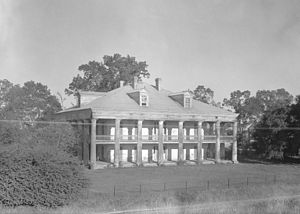Uncle Sam Plantation
| Uncle Sam Plantation | |
|---|---|

The main house in 1936
|
|
| Location | Convent, Louisiana vicinity |
| Coordinates | 30°02′14″N 90°49′57″W / 30.03709°N 90.83247°WCoordinates: 30°02′14″N 90°49′57″W / 30.03709°N 90.83247°W |
| Built | 1829–1843 |
| Demolished | 1940 |
| Architectural style(s) | Greek Revival |
| Governing body | Private |
Uncle Sam Plantation, originally known as Constancia, was a historic sugar plantation and elaborate Greek Revival-style mansion on the Mississippi River, near Convent in St. James Parish, Louisiana. It was established during the 1810s, with the main house and numerous outbuildings built by Samuel Pierre Auguste Fagot between 1829 and 1843. Once renowned as one of the most intact and architecturally-unified plantation complexes in the Southeastern United States, all of the structures were demolished to make way for construction of a new river levee in 1940. It was recorded by the Historic American Buildings Survey prior to its destruction.
The plantation was established by Colonel Joseph Constance when he acquired several tracts of land at the location following the War of 1812. Pierre Auguste Samuel Fagot, usually known as Samuel Fagot, acquired the plantation and other St. James Parish properties beginning in 1829. A native of La Rochelle, France, he emigrated to the United States and was living in the vicinity of Convent by 1828. He married Emilie Jourdain and had two daughters, Marie Emilie Eugenie and Felicie. Marie Emilie Eugenie married Jacques Auguste Demophon Tureaud and Felicie married Lucien Malus.
By the time of Samuel Fagot's death in 1858, he was one of the largest landowners in St. James Parish. The plantation went to his widow after his death, but his son-in-law, Lucien Malus, operated the plantation. Following the Civil War, the plantation, which had been called Constancia up until that time, came to be called Uncle Sam instead. Many different stories have attempted to explain the name. One is that it came from the sugar containers from the plantation being marked for export with "U.S." for the nation of origin. Others claim that it referred to Samuel Fagot himself. None has been confirmed by historians.
...
Wikipedia
